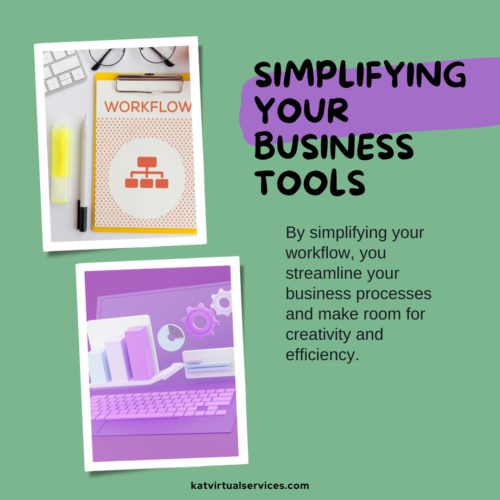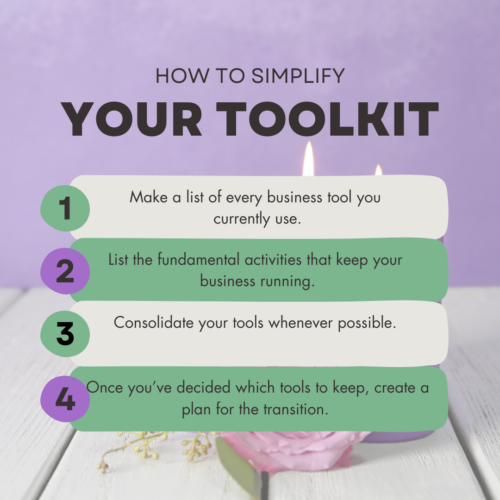I recently watched a client’s small business nearly grind to a halt because she was drowning in productivity apps. The irony wasn’t lost on me: tools meant to make her life easier were doing exactly the opposite. She had one app for task management, another for time tracking, three different communication platforms, and countless other “essential” tools that were supposed to streamline her workflow.
Sound familiar? You might be nodding your head right now if you’re running a small online business. We’ve all been there, chasing the promise of the perfect tool to make everything go into place finally. But here’s the thing: sometimes, the best solution isn’t adding another tool to your stack. It’s taking some away.
The Tool Trap: How We Got Here
Remember when you first started your business? Maybe you read articles about “must-have” business tools, or perhaps a colleague raved about their latest productivity app discovery. Before you knew it, your digital toolbar looked like a software developer’s app drawer.
It’s not your fault. We live in an age with an app for everything, and each one promises to solve all your problems. Need to manage projects? There are dozens of options. Want to track time? Here are twenty apps that’ll do that for you. Looking to streamline your social media? Take your pick from hundreds of tools.

But here’s what nobody tells you: every new tool you add to your workflow comes with hidden costs. There’s the learning curve, the mental overhead of switching between apps, and the time spent maintaining and updating them. Let’s not forget the actual financial cost of all those monthly subscriptions.
The Warning Signs: Is Your Toolkit Working Against You?
Before we dive into the solution, let’s talk about some red flags that might indicate you’re suffering from tool overload:
- You spend more time organizing your tools than using them to complete work. (If you’ve ever spent an entire afternoon setting up a new project management system, you know what I mean.)
- You frequently forget which tool you use to store specific information. Was that important client note in Evernote, Notion, or your project management app?
- You’re paying for features you never use because they’re bundled with the ones you need.
- Your team members constantly ask, “Where should I put this?” or “Which app are we using for that now?”
- You have multiple tools that essentially do the same thing.
If any of these scenarios hit close to home, don’t worry. You’re not alone, and there’s a way out.
The Power of Letting Go
Simplifying your workflow isn’t just about reducing the number of tools you use — it’s about creating space for what really matters. Think of it like decluttering your house. Sure, that bread maker seemed like a great idea when you bought it, but if it’s been collecting dust for the past year, it’s just taking up valuable counter space.
The same principle applies to your business tools. Every app that sits unused in your digital workspace creates mental clutter. It’s one more thing to think about, one more password to remember, one more subscription to manage.
When you start letting go of unnecessary tools, something magical happens. You’ll notice:
- Your mind feels clearer. Instead of juggling multiple systems, you can focus on the work that moves your business forward.
- Your processes become more streamlined. With fewer tools to manage, you can create simpler, more efficient workflows.
- Your team will become more productive. When everyone knows exactly which tool to use for what purpose, collaboration will become seamless.
- Your budget gets a break. Those $10-20 monthly subscriptions add up faster than you think.
A Practical Guide to Simplifying Your Toolkit
Let’s get practical. Here’s how to start simplifying your workflow:
Step 1: The Tool Audit
First, make a list of every business tool you currently use. Include everything from your project management software to that social media scheduling tool you signed up for last year. Next to each one, write down:
- What you use it for
- How often you actually use it
- What you’re paying for it
- Whether another tool you have could do the same job
This exercise alone often reveals surprising insights about your tool usage patterns.

Step 2: The Core Process Analysis
Instead of starting with the tools, start with your core business processes. What are the fundamental activities that keep your business running? These might include:
- Client communication
- Project management
- Financial tracking
- Content creation and scheduling
- Team collaboration
Now, map your existing tools to these processes. You might find that some processes are over-served (with multiple tools doing the same thing) while others are under-served.
Step 3: The Consolidation Strategy
Look for opportunities to consolidate tools. For example:
- Could your project management tool also handle your task management needs?
- Does your team really need both Slack and Microsoft Teams?
- Could you use your CRM’s built-in email marketing features instead of maintaining a separate email marketing platform?
The goal isn’t to find the perfect all-in-one solution (they rarely exist) but to find tools that can effectively handle multiple aspects of your workflow.
Step 4: The Implementation Plan
Once you’ve decided which tools to keep and which to let go, create a plan for the transition. This might include:
- Exporting important data from tools you’re retiring
- Training your team on new workflows
- Setting up automated processes in your consolidated toolkit
- Creating documentation for your simplified systems
Making It Stick: Best Practices for a Simplified Workflow
Simplifying your workflow is one thing; keeping it simple is another. Here are some guidelines to help maintain your streamlined system:
The One-In-One-Out Rule
Before adding any new tool to your workflow, identify which existing tool it will replace. This helps prevent tool creep from returning.
The Quarterly Review
Set a calendar reminder to review your tool usage every three months. Are you getting value from each tool? Have any become redundant? Have your needs changed?
The Integration Priority
When evaluating new tools, prioritize those that integrate well with your existing core tools. The ability to automate workflows between apps can be more valuable than having the “perfect” tool that exists in isolation.
The Road Ahead: Embracing Simplicity
Remember: the goal isn’t to have the most sophisticated tech stack or use every tool feature. The goal is to have a workflow that supports your business without becoming a business.
Start small. Maybe consolidate your communication tools or choose one project management system to rule them all. Pay attention to how these changes affect your productivity and stress levels.
As you simplify, you might find yourself working less but accomplishing more. That’s not magic — it’s what happens when you stop letting your tools run you and start making them work for you instead.
Your business deserves a workflow that empowers rather than overwhelms. Sometimes, that means doing less to achieve more. After all, in a world constantly pushing us to add more, the ability to subtract might be your greatest competitive advantage.
Remember: The best tool isn’t always the newest or the most feature-rich — it’s the one that helps you get your work done without getting in your way.

